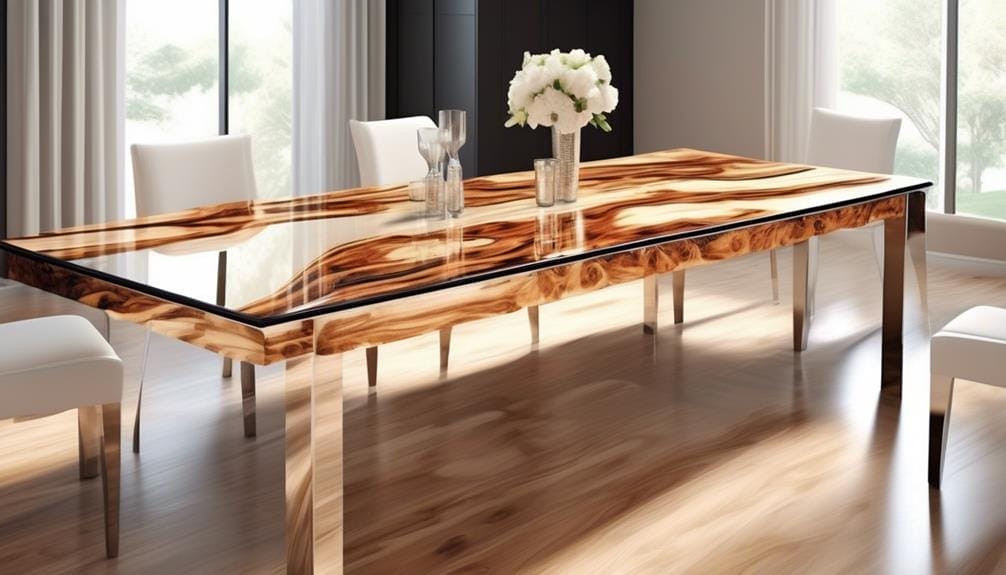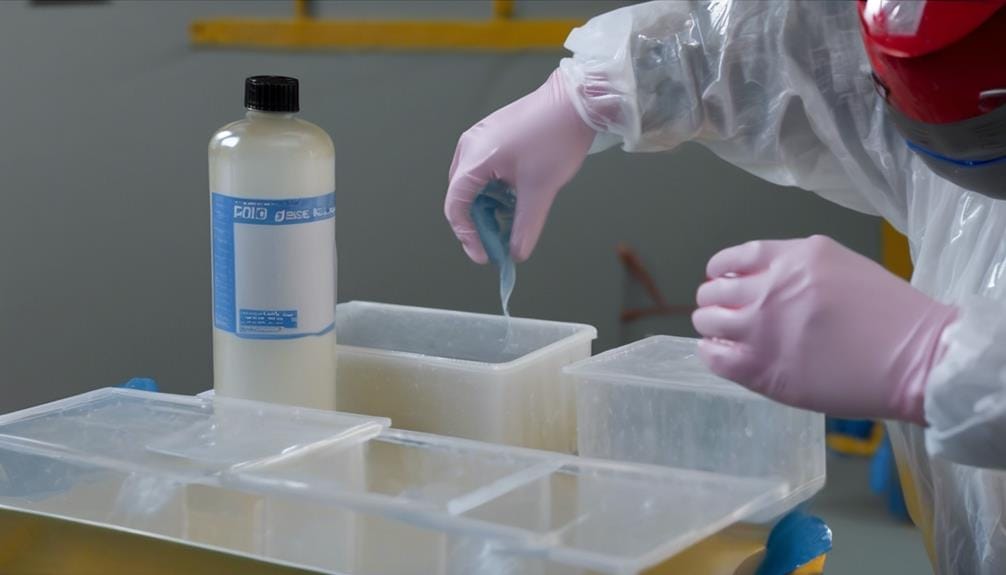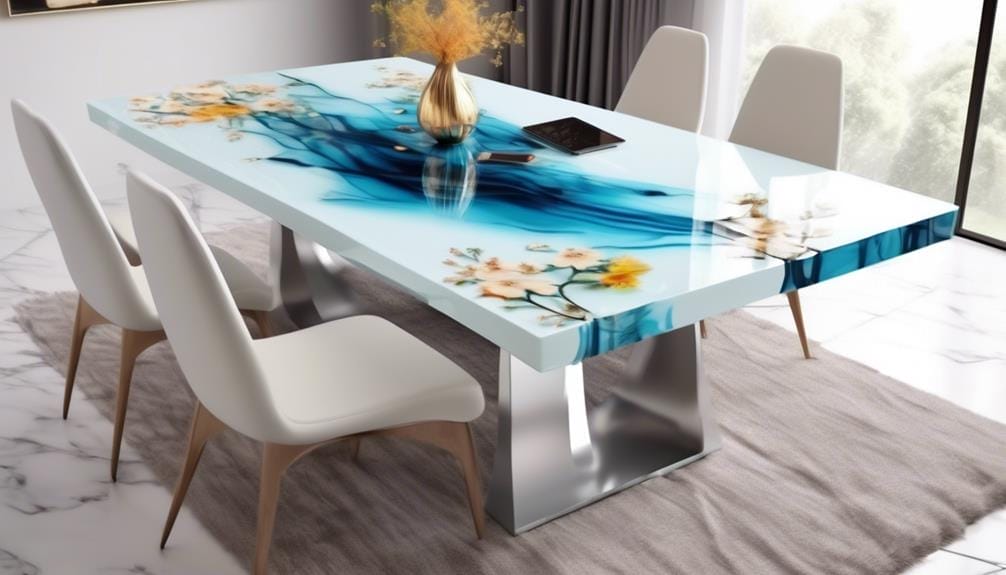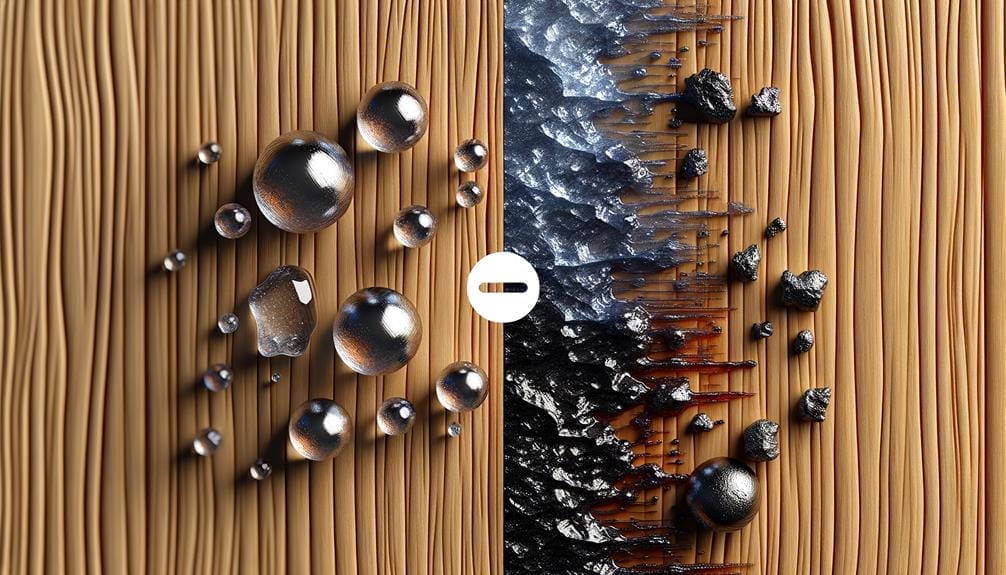As you step into the world of epoxy coatings, you’ll find yourself faced with a choice between two formidable contenders: Liquid Glass Epoxy and traditional epoxy. Like a battle between the old and the new, these two options offer different advantages and characteristics that can make your decision a tough one.
But fear not, for in this discussion, we will uncover the strengths and weaknesses of both, guiding you towards an informed choice that will leave you satisfied.
So, let’s dive into the fascinating realm of epoxy coatings and unravel the secrets behind Liquid Glass Epoxy versus its traditional counterpart.
Key Takeaways
- Liquid glass epoxy offers superior durability and weather resistance compared to traditional epoxy.
- Liquid glass epoxy provides a more seamless and self-leveling application process.
- Both liquid glass epoxy and traditional epoxy offer a wide range of aesthetic options.
- Liquid glass epoxy and traditional epoxy are both safe, non-toxic, and environmentally friendly materials.
Performance Differences
When comparing liquid glass epoxy and traditional epoxy, it’s important to understand the performance differences between the two materials.
Liquid glass epoxy offers exceptional durability, surpassing traditional coatings in its ability to withstand abrasion, wear and tear, chemical spills, and heat. It creates a water- and stain-resistant surface that’s easy to clean and maintain, making it ideal for wet environments like bathrooms and kitchens.
Traditional epoxy, on the other hand, is also waterproof and provides a smooth, flawless surface due to its self-leveling nature. It’s commonly used in heavy-duty woodworking projects, such as river tables, without chipping, cracking, or breaking.
Both liquid glass epoxy and traditional epoxy are easy to install and maintain, requiring minimal specialized tools or knowledge. They’re resistant to staining and other forms of damage, contributing to a cleaner and healthier environment without the use of dangerous chemicals or toxins.
Both materials offer a range of aesthetic options, with an endless color palette and the ability to add custom designs and textures. Liquid glass epoxy allows for the creation of stunning designs and patterns, adding a touch of panache to any room.
Durability Factors
When comparing liquid glass epoxy and traditional epoxy in terms of durability, there are several factors to consider.
Firstly, both types of epoxy offer exceptional longevity, with the ability to withstand years of use without chipping or cracking.
Additionally, they exhibit high impact resistance, making them suitable for heavy-duty applications.
Lastly, both epoxy surfaces and liquid glass coatings are weather-resistant, allowing them to withstand the elements and maintain their durability over time.
Longevity
Epoxy surfaces and liquid glass coatings exhibit exceptional longevity, surpassing that of traditional coatings, due to their robust bonding capabilities, resistance to wear and tear, chemicals, and heat. These coatings are designed to withstand heavy use and remain intact for decades.
Epoxy surfaces, such as those used for river tables, are highly durable and can withstand the rigors of heavy-duty woodworking projects without chipping, cracking, or breaking. Moreover, epoxy surfaces are waterproof, making them ideal for wet environments like bathrooms and kitchens.
Liquid glass coatings, on the other hand, provide an extra layer of protection, creating a water- and stain-resistant surface that’s easy to clean and maintain.
With their long-lasting durability and low-maintenance requirements, both liquid glass epoxy and traditional epoxy coatings are excellent choices for those seeking a durable and resilient surface.
Impact Resistance
With their exceptional impact resistance and robust bonding capabilities, both liquid glass and epoxy surfaces offer a highly durable and long-lasting solution for various applications.
Epoxy resin, known for its strong bond with the substrate, provides excellent resistance to abrasion, wear and tear, and chemical spills, ensuring durability in high-traffic areas. When it comes to impact resistance, epoxy is particularly advantageous for river tables and heavy-duty woodworking projects, preventing chipping, cracking, or breaking.
Additionally, the impact resistance of epoxy surfaces makes them ideal for wet environments like bathrooms and kitchens, where durability is crucial.
Liquid glass coating, on the other hand, adds an extra layer of protection, creating a durable and impact-resistant surface that’s easy to maintain.
Weather Resistance
Liquid glass and epoxy surfaces are known for their exceptional weather resistance, making them highly suitable for a wide range of indoor and outdoor applications. These surfaces offer long-lasting durability, outlasting traditional coatings for decades. They are resistant to abrasion, wear and tear, chemical spills, and heat. Epoxy surfaces are also waterproof, making them ideal for wet environments such as bathrooms and kitchens. Additionally, the liquid glass coating adds an extra layer of protection, creating a water- and stain-resistant surface that is easy to clean and maintain. To illustrate the weather resistance of liquid glass epoxy compared to traditional epoxy, the following table provides a comparison:
| Weather Resistance Factors | Liquid Glass Epoxy | Traditional Epoxy |
|---|---|---|
| Durability | Excellent | Good |
| Water Resistance | High | Moderate |
| Stain Resistance | High | Moderate |
| UV Resistance | High | Moderate |
As shown in the table, liquid glass epoxy excels in all weather resistance factors, demonstrating its superior durability and suitability for a variety of challenging environments.
Application Process Comparison
The application process for liquid glass epoxy involves a straightforward pouring and leveling technique. Unlike traditional epoxy, which may require mixing and applying with a roller, liquid glass epoxy can often be applied simply by pouring it onto the desired surface and using a leveling tool to ensure an even distribution. This process offers a more seamless and self-leveling application compared to traditional epoxy, which may require more attention to achieve a smooth finish. Additionally, liquid glass epoxy may have a longer curing time, which requires more patience during the application process.
Traditional epoxy, on the other hand, may require specialized tools such as rollers or brushes for application. It may also involve more steps to achieve the desired aesthetic effects, such as adding color or texture. In contrast, liquid glass epoxy provides a simpler process for achieving similar results. The pouring technique allows for easier application and can result in a smooth and glossy finish.
Aesthetics and Visual Appeal

To enhance the visual appeal and aesthetics of your project, epoxy surfaces and liquid glass offer a wide range of options with endless color palettes and the ability to add custom designs and textures. These materials provide unique and eye-catching surfaces that can truly elevate the overall look of any room or product. By incorporating multicolored chips, glitter, and metallic flakes, you can add a touch of panache to your space, creating a stunning and personalized result.
One of the key advantages of epoxy surfaces is their self-leveling property, which ensures a smooth and flawless finish. This contributes to the overall aesthetics of the project, making it visually appealing and professional-looking.
On the other hand, liquid glass epoxy takes the visual appeal to another level by allowing you to create intricate designs and patterns. The transparency and glossy finish of the liquid glass add depth and sophistication to the surface.
Moreover, both epoxy surfaces and liquid glass can enhance the appearance of wooden homewares. Whether it’s a wooden table, countertop, or decorative item, applying epoxy or liquid glass can bring out the natural beauty of the wood while adding a layer of protection and durability.
Cost Comparison
When comparing the cost of liquid glass epoxy and traditional epoxy, it’s important to consider the price difference and the long-term cost-effectiveness of each option.
Although traditional epoxy may have lower upfront costs, liquid glass offers superior durability and minimal maintenance needs, making it a more cost-effective choice in the long run.
While traditional epoxy may seem budget-friendly initially, investing in liquid glass can provide a more economical alternative in terms of longevity and future repairs or replacements.
Price Difference
Liquid glass epoxy is generally priced higher than traditional epoxy due to its enhanced clarity and UV resistance. The cost of liquid glass epoxy is typically higher because of the advanced features it offers.
Traditional epoxy, on the other hand, is a more affordable option for those who are seeking a durable coating. The price difference between liquid glass epoxy and traditional epoxy can greatly influence the overall cost of a project.
It’s important to consider this cost comparison when planning a coating project, as it can impact the budget and feasibility of the endeavor. While liquid glass epoxy may be more expensive, its enhanced properties may be worth the investment for certain applications where clarity and UV resistance are crucial.
Cost-Effective Option
Liquid glass epoxy and traditional epoxy both have their own advantages and disadvantages, but now let’s explore the cost-effective option of these coatings. When it comes to cost, liquid glass and epoxy surfaces offer significant benefits over materials like tile or marble. Here are three reasons why they’re a cost-effective option:
- They can be applied directly over existing surfaces, eliminating the need for costly demolition and preparation.
- Epoxy materials can be purchased in large quantities for a relatively low cost, making them a cost-effective solution.
- Their long-lasting durability ensures a good return on investment, making them a cost-effective option for various projects.
In addition to these factors, liquid glass coating also helps reduce energy costs by creating a barrier that prevents heat transfer, further adding to its cost-effectiveness.
Budget-Friendly Alternative
For a cost-effective alternative that offers durability and aesthetic appeal, consider the budget-friendly option of liquid glass epoxy compared to traditional materials.
Liquid glass epoxy and epoxy resin can be a more affordable choice when compared to materials like tile or marble. Not only are they cheaper in terms of initial cost, but they also save money on demolition and preparation since they can be applied directly over existing surfaces.
Epoxy materials can be purchased in large quantities for a relatively low cost, providing a good return on investment due to their long-lasting durability. Additionally, liquid glass coating helps reduce energy costs by creating a barrier that prevents heat transfer, making it a cost-effective option in the long run.
These alternatives provide budget-friendly options for achieving durable, aesthetically pleasing surfaces in various applications.
Ease of Installation
With their user-friendly installation process and minimal maintenance requirements, both liquid glass epoxy and traditional epoxy offer a convenient and versatile solution for DIY enthusiasts and professionals alike. Whether you choose liquid glass epoxy or traditional epoxy, you can expect a hassle-free installation experience.
Here are some key points to consider:
- Easy application: Both liquid glass epoxy and traditional epoxy can be applied without the need for specialized tools or extensive knowledge. Simply follow the instructions provided and you’ll be able to achieve a smooth and seamless finish.
- Minimal maintenance: Once cured, both liquid glass epoxy and traditional epoxy require minimal upkeep. They’re resistant to staining and other forms of damage, making it easy to clean spills and messes with just a wet cloth.
- Versatility: Whether you’re looking to coat countertops, floors, or other surfaces, both liquid glass epoxy and traditional epoxy are suitable for various applications. They provide a durable and long-lasting finish that can withstand everyday wear and tear.
Health and Safety Considerations

When working with liquid glass epoxy or traditional epoxy, it’s crucial to be aware of the potential health hazards they pose.
Both types of epoxy can release hazardous fumes and vapors, making it necessary to work in a well-ventilated area and wear appropriate personal protective equipment, such as gloves and a respirator.
Additionally, the high viscosity of liquid glass epoxy and the heat buildup during curing can lead to exothermic reactions, requiring careful handling and adherence to manufacturer’s instructions to prevent accidents.
Hazardous Fumes and Vapors
To ensure the health and safety of workers, proper ventilation and protective gear are necessary when handling traditional epoxy due to the emission of hazardous fumes and vapors. When working with traditional epoxy, it’s crucial to use a respirator, gloves, and eye protection to minimize exposure to harmful fumes and vapors.
Additionally, proper workspace ventilation, such as using fans or opening windows, is essential to reduce the risk of inhaling hazardous fumes during application and curing.
In contrast, liquid glass epoxy is formulated to have minimal to no odor and emit low levels of volatile organic compounds (VOCs), making it safer to work with in enclosed spaces. This reduces the health and safety risks associated with hazardous fumes and vapors, providing a more user-friendly application experience.
Protective Equipment Requirements
Proper handling of epoxy resin and liquid glass requires the use of protective equipment, such as gloves, safety goggles, and a respirator, to ensure the safety and well-being of individuals involved. These protective measures are crucial due to the potential hazards associated with these materials.
| Protective Equipment | Purpose |
|---|---|
| Gloves | Prevent skin contact and protect against chemical burns |
| Safety goggles | Shield the eyes from splashes and potential eye damage |
| Respirator | Filter out harmful fumes and vapors to prevent inhalation |
| Ventilation/Workspace | Ensure proper airflow and minimize exposure to airborne chemicals |
In addition to these requirements, it is recommended to wear long-sleeved clothing and closed-toe shoes to minimize skin exposure and protect against accidental spills. In case of any accidental contact with the skin, having access to a first aid kit is essential for immediate treatment. It is crucial to follow the manufacturer’s specific safety recommendations and guidelines for the protective equipment required for each product and application. By adhering to these precautions, you can ensure a safer working environment when using liquid glass epoxy.
Potential Health Hazards
The potential health hazards associated with epoxy surfaces and liquid glass are minimal, making them a safe choice for creating a healthier and cleaner environment. Unlike traditional epoxy, these materials are non-toxic and don’t emit harmful fumes or odors. This means that you can enjoy the benefits of epoxy coatings without worrying about the negative impact on your health.
Additionally, the seamless nature of epoxy surfaces prevents the accumulation of bacteria, mold, mildew, and other allergens, contributing to a cleaner and healthier living space. These surfaces are especially beneficial in areas like hospitals and schools, where maintaining air quality and hygiene is crucial.
Furthermore, the liquid glass coating adds an extra layer of protection, creating a water- and stain-resistant surface that’s easy to clean and maintain, promoting a hygienic and safe environment.
Versatility of Use

Liquid glass epoxy and traditional epoxy offer a wide range of possibilities for design and application, making them highly versatile materials for various projects. Whether you’re looking to cover countertops, floors, walls, or furniture, both liquid glass epoxy and traditional epoxy can be utilized to create unique and personalized spaces. The ability to mix and match colors, designs, and finishes allows for endless customization options. This versatility makes liquid glass epoxy and traditional epoxy suitable for both residential and commercial projects, adding a touch of uniqueness to any space.
In addition to their use in surfacing, liquid glass epoxy and traditional epoxy can enhance the appearance of wooden homewares. With an endless color palette and the ability to add custom designs and textures, these materials offer a wide range of aesthetic options. From creating stunning designs and patterns to providing a durable and long-lasting finish, liquid glass epoxy and traditional epoxy are ideal for a variety of applications.
Whether you’re a homeowner looking to revamp your living space or a business owner in need of a durable and attractive solution, liquid glass epoxy and traditional epoxy provide the versatility needed to bring your vision to life. Their wide range of applications and customization options make them go-to materials for numerous projects.
Environmental Impact
By utilizing eco-friendly materials and offering numerous benefits, liquid glass epoxy and traditional epoxy have a positive environmental impact. Both options are made from non-toxic substances and are 100% recyclable, ensuring responsible disposal and reducing harm to the environment.
Here are three ways in which liquid glass epoxy and traditional epoxy contribute to a greener future:
- Energy Efficiency: Liquid glass epoxy has the ability to create a barrier that prevents heat transfer. By applying this coating to surfaces, you can reduce energy costs by maintaining a more stable indoor temperature. This not only benefits the environment by conserving energy but also helps to create a sustainable and energy-efficient living or working space.
- Improved Air Quality: Liquid glass epoxy and traditional epoxy provide a cleaner and healthier environment by eliminating the use of dangerous chemicals or toxins. This results in improved air quality in homes, offices, and other spaces where these materials are used. By preventing the accumulation of bacteria, mold, mildew, and other allergens, liquid glass epoxy and traditional epoxy create a safer and more hygienic environment for everyone.
- Longevity: Both liquid glass epoxy and traditional epoxy offer long-lasting durability. Their seamless nature prevents the accumulation of dirt, dust, and other particles, reducing the need for frequent cleaning and maintenance. This not only saves time and effort but also reduces the use of cleaning products, contributing to a more sustainable and eco-friendly lifestyle.
Maintenance and Longevity

With their exceptional durability and low maintenance requirements, epoxy surfaces and liquid glass offer a long-lasting solution for a wide range of projects. When it comes to maintenance and longevity, epoxy surfaces and liquid glass come out on top. These materials are known for their ability to withstand the test of time, providing a clear and durable protective layer that can outlast traditional coatings for decades. They’re resistant to abrasion, wear and tear, chemical spills, and heat, making them ideal for heavy-duty woodworking projects and wet environments like bathrooms and kitchens.
Maintenance for epoxy surfaces and liquid glass is minimal. Spills and messes can easily be wiped away, leaving the surface looking as good as new. In the case of liquid glass, its top-clear water and stain-resistant surface makes cleaning and maintenance a breeze. These surfaces offer a seamless, non-toxic, and environmentally friendly option that prevents the accumulation of bacteria, mold, mildew, and other allergens.
The longevity of epoxy surfaces and liquid glass, combined with their ease of installation and resistance to staining and damage, make them a versatile and cost-effective solution for both residential and commercial projects. So whether you’re looking to protect your floors, countertops, or other surfaces, epoxy surfaces and liquid glass provide a durable and low-maintenance solution that will stand the test of time.
Conclusion and Final Verdict
In summary, the unparalleled durability and protection of liquid glass epoxy make it the superior choice for long-lasting and resistant surfaces. When comparing liquid glass epoxy to traditional epoxy, the clear finish and deep pour capabilities set it apart.
With liquid glass epoxy, you can achieve a crystal-clear finish that enhances the natural beauty of the underlying surface. Whether you’re using it for countertops, tabletops, or flooring, the clarity and depth of the liquid glass epoxy create a stunning visual impact.
Additionally, the deep pour capability of liquid glass epoxy allows for thicker applications without compromising its performance. This means you can create thicker layers that provide increased durability and protection for your surfaces. Whether you’re aiming for a glossy, smooth surface or a textured, artistic design, liquid glass epoxy can deliver the desired result.
Furthermore, liquid glass epoxy offers excellent resistance against scratches, stains, chemicals, and UV damage. Its superior durability ensures that your surfaces will withstand the test of time, even in high-traffic areas or harsh environments. With its long-lasting properties, liquid glass epoxy proves to be a cost-effective choice, as it requires minimal maintenance and provides a durable solution for years to come.
Frequently Asked Questions
Is Liquid Glass the Same as Epoxy?
Yes, liquid glass is a type of epoxy. While epoxy resin is a general term for various types of epoxy, liquid glass refers specifically to a high-gloss, clear epoxy used for applications such as coatings and sealants.
What Are the Advantages of Epoxy Glass?
Liquid glass epoxy offers numerous advantages. It is highly durable, aesthetically pleasing, cost-effective, easy to install and maintain, and has health benefits. Its applications are wide-ranging, enhancing the appearance and longevity of various surfaces.
What Is the Difference Between Marine Epoxy and Regular Epoxy?
Regular epoxy and marine epoxy differ in their formulation and intended use. Marine epoxy is specifically designed to withstand harsh marine environments, offering superior resistance to water, chemicals, and UV rays. Regular epoxy, on the other hand, is more versatile and can be used for various applications.
What Is the Best Epoxy to Use?
Evaluate factors such as curing time, durability, and compatibility with your surface. Assess your specific needs and consult product specifications for guidance.
Conclusion
In conclusion, when comparing liquid glass epoxy to traditional epoxy, the former emerges as the superior choice in terms of performance, durability, aesthetics, cost-effectiveness, versatility, and environmental impact.
With its exceptional durability and resistance to abrasion, chemicals, and heat, liquid glass epoxy outshines traditional epoxy coatings. Additionally, its water and stain-resistant properties make it easy to clean and maintain.
Furthermore, the non-toxic nature of liquid glass epoxy ensures a healthier environment by preventing the accumulation of bacteria and allergens.
Overall, liquid glass epoxy is the clear winner in providing long-lasting protection and visual appeal.





